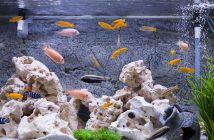New seawater is going to be mixed many times in the future. Why not take a little extra trouble in the initial mix and save a lot of time later?
When purchasing the sea salt, obtain salt that is specifically designed for use with R/O water, as this should be used rather than tap water.
The net gallonage of the aquarium is known. Having purchased the dry sea salt, it is fairly easy to guess the amount that is needed to meet the intended SG of the aquarium seawater, by looking at the suggestions of the manufacturer. Measure out a little less than it appears may be needed. Once the salt has been measured out, weigh it and take a note. It is recommended that grams are used when weighing the salt.
Before we consider mixing saltwater, fresh water is needed. It has already been decided that Reverse Osmosis (R/O) water will be used. R/O water takes a considerable while to produce in any quantity, so the collection must be set in motion in good time so as to be available for the mix. The R/O unit instructions will give a reasonable estimate of how many gallons can be produced in a given time, but add a little more time to cover variables.
So the mixing bucket is ready, plus the seawater heater and air pump. Place the weighed salt in the bucket and pour sufficient R/O water in to bring the level to the required number of gallons. Give the salt a good stir to initially mix it in, a wooden stick (clean) will do. Set off the heater and air pump. Remember that the temperature of the mix needs to be at or very close to the temperature of the seawater in the aquarium. (Also, temperature has an effect on an SG reading.) Leave for about 8 to 12 hours, more does no harm, this will allow the salt to fully mix and the temperature to stabilize.
After the suggested time, measure the SG with the hydrometer:
a. If the SG reading is too low, measure out a little more salt and take a note of the weight. Add the salt to the bucket and allow more time for the salt to be fully dissolved. Then test again, if more salt is needed then proceed as above. If the mix is correct then add the salt weights together and put the total in the notebook.
b. If the SG reading is too high, add a little reverse osmosis water (note the amount) to the mix and give time for the temperature to stabilise. Test again. If still too high, add a little more RO water (again note the amount). If correct, note the total amount of additional RO water used. By fraction, the salt can be reduced for the next mix.
Often, the correct amount of salt to be used in the mix is arrived at by the methods of both a. and b. above. Once the amount of salt by weight is known and noted, new seawater mixing is straightforward. However, for the first few new seawater mixes it is recommended that the SG is measured for each mix, until confident that the SG is consistently correct.

Peter Cunningham and John Cunningham combined have been keeping salt water aquarium’s for nearly 35 years. Visit their site Aquarists Online if you are interested in Saltwater Aquarium Resources And Information.



